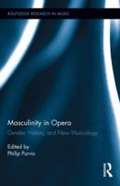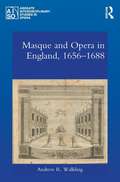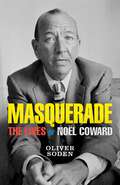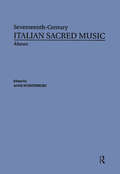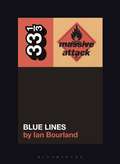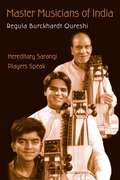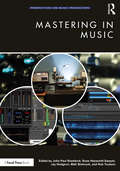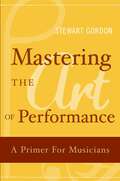- Table View
- List View
Masculinity and Western Musical Practice
by Kirsten GibsonHow have men used art music? How have they listened to and brandished the musical forms of the Western classical tradition and how has music intervened in their identity formations? This collection of essays addresses these questions by examining some of the ways in which men, music and masculinity have been implicated with each other since the Middle Ages. Feminist musicologies have already dealt extensively with music and gender, from the 'phallocentric' tendencies of the Western tradition, to the explicit marginalization of women from that tradition. This book builds on that work by turning feminist critical approaches towards the production, rhetorical engagement and subversion of masculinities in twelve different musical case studies. In other disciplines within the arts and humanities, 'men's studies' is a well-established field. Musicology has only recently begun to address critically music's engagement with masculinity and as a result has sometimes thereby failed to recognize its own discursive misogyny. This book does not seek to cover the field comprehensively but, rather, to explore in detail some of the ways in which musical practices do the cultural work of masculinity. The book is structured into three thematic sections: effeminate and virile musics and masculinities; national masculinities, national musics; and identities, voices, discourses. Within these themes, the book ranges across a number of specific topics: late medieval masculinities; early modern discourses of music, masculinity and medicine; Renaissance Italian masculinities; eighteenth-, nineteenth- and early twentieth-century ideas of creativity, gender and canonicity; masculinity, imperialist and nationalist ideologies in the nineteenth century, and constructions of the masculine voice in late nineteenth- and twentieth-century opera and song. While the case studies are methodologically disparate and located in different historical and geographical locations, they all share a common conc
Masculinity and Western Musical Practice
by Kirsten GibsonHow have men used art music? How have they listened to and brandished the musical forms of the Western classical tradition and how has music intervened in their identity formations? This collection of essays addresses these questions by examining some of the ways in which men, music and masculinity have been implicated with each other since the Middle Ages. Feminist musicologies have already dealt extensively with music and gender, from the 'phallocentric' tendencies of the Western tradition, to the explicit marginalization of women from that tradition. This book builds on that work by turning feminist critical approaches towards the production, rhetorical engagement and subversion of masculinities in twelve different musical case studies. In other disciplines within the arts and humanities, 'men's studies' is a well-established field. Musicology has only recently begun to address critically music's engagement with masculinity and as a result has sometimes thereby failed to recognize its own discursive misogyny. This book does not seek to cover the field comprehensively but, rather, to explore in detail some of the ways in which musical practices do the cultural work of masculinity. The book is structured into three thematic sections: effeminate and virile musics and masculinities; national masculinities, national musics; and identities, voices, discourses. Within these themes, the book ranges across a number of specific topics: late medieval masculinities; early modern discourses of music, masculinity and medicine; Renaissance Italian masculinities; eighteenth-, nineteenth- and early twentieth-century ideas of creativity, gender and canonicity; masculinity, imperialist and nationalist ideologies in the nineteenth century, and constructions of the masculine voice in late nineteenth- and twentieth-century opera and song. While the case studies are methodologically disparate and located in different historical and geographical locations, they all share a common conc
Masculinity, Class and Music Education: Boys Performing Middle-Class Masculinities through Music (Palgrave Studies in Gender and Education)
by Clare HallThis book offers a provocative sociological examination of masculinity, class and music education within the context of a unique and fascinating culture: the classical musical world of choirboys. The myriad cultural meanings embodied in the ‘boy voice’ are unravelled through compelling musical narratives of young choirboys, their mothers, and their teachers. The book investigates how boys negotiate dominant gender-class discourses and the various pedagogies involved in producing middle-class masculinities during primary school and early years contexts. Drawing on the theoretical resources of Bourdieu to develop the concept of ‘musical habitus’, the continued symbolic distinction of the choirboy is analysed in order to better understand how culture is simultaneously reproduced and evolving through music. This interdisciplinary work at the juncture of pedagogy and culture will appeal to social science researchers, educators and arts practitioners interested in the sociocultural dynamics of music.
Masculinity in Opera: Gender, History, and New Musicology (Routledge Research In Music Ser. #6)
by Philip PurvisThis book addresses the ways in which masculinity is negotiated, constructed, represented, and problematized within operatic music and practice. Although the consideration of masculine ontology and epistemology has pervaded cultural and sociological studies since the late 1980s, and masculinity has been the focus of recent if sporadic musicological discussion, the relationship between masculinity and opera has so far escaped detailed critical scrutiny. Operating from a position of sympathy with feminist and queer approaches and the phallocentric tendencies they identify, this study offers a unique perspective on the cultural relativism of opera by focusing on the male operatic subject. Anchored by musical analysis or close readings of musical discourse, the contributions take an interdisciplinary approach by also engaging with theatre, popular music, and cultural musicology scholarship. The various musical, theoretical, and socio-political trajectories of the essays are historically dispersed from seventeenth to twentieth- first-century operatic works and practices, visiting masculinity and the operatic voice, the complication or refusal of essentialist notions of masculinity, and the operatic representation of the ‘crisis’ of masculinity. This volume will not only enliven the study of masculinity in opera, but be an appealing contribution to music scholars interested in gender, history, and new musicology.
Masculinity in Opera: Gender, History, and New Musicology (PDF) (Routledge Research In Music Ser. #6)
by Philip PurvisThis book addresses the ways in which masculinity is negotiated, constructed, represented, and problematized within operatic music and practice. Although the consideration of masculine ontology and epistemology has pervaded cultural and sociological studies since the late 1980s, and masculinity has been the focus of recent if sporadic musicological discussion, the relationship between masculinity and opera has so far escaped detailed critical scrutiny. Operating from a position of sympathy with feminist and queer approaches and the phallocentric tendencies they identify, this study offers a unique perspective on the cultural relativism of opera by focusing on the male operatic subject. Anchored by musical analysis or close readings of musical discourse, the contributions take an interdisciplinary approach by also engaging with theatre, popular music, and cultural musicology scholarship. The various musical, theoretical, and socio-political trajectories of the essays are historically dispersed from seventeenth to twentieth- first-century operatic works and practices, visiting masculinity and the operatic voice, the complication or refusal of essentialist notions of masculinity, and the operatic representation of the ‘crisis’ of masculinity. This volume will not only enliven the study of masculinity in opera, but be an appealing contribution to music scholars interested in gender, history, and new musicology.
Masque and Opera in England, 1656-1688 (Ashgate Interdisciplinary Studies in Opera)
by Andrew R. WalklingMasque and Opera in England, 1656–1688 presents a comprehensive study of the development of court masque and through-composed opera in England from the mid-1650s to the Revolution of 1688–89. In seeking to address the problem of generic categorization within a highly fragmentary corpus for which a limited amount of documentation survives, Walkling argues that our understanding of the distinctions between masque and opera must be premised upon a thorough knowledge of theatrical context and performance circumstances. Using extensive archival and literary evidence, detailed textual readings, rigorous tabular analysis, and meticulous collation of bibliographical and musical sources, this interdisciplinary study offers a host of new insights into a body of work that has long been of interest to musicologists, theatre historians, literary scholars and historians of Restoration court and political culture, but which has hitherto been imperfectly understood. A companion volume will explore the phenomenon of "dramatick opera" and its precursors on London’s public stages between the early 1660s and the first decade of the eighteenth century.
Masque and Opera in England, 1656-1688 (Ashgate Interdisciplinary Studies in Opera)
by Andrew R. WalklingMasque and Opera in England, 1656–1688 presents a comprehensive study of the development of court masque and through-composed opera in England from the mid-1650s to the Revolution of 1688–89. In seeking to address the problem of generic categorization within a highly fragmentary corpus for which a limited amount of documentation survives, Walkling argues that our understanding of the distinctions between masque and opera must be premised upon a thorough knowledge of theatrical context and performance circumstances. Using extensive archival and literary evidence, detailed textual readings, rigorous tabular analysis, and meticulous collation of bibliographical and musical sources, this interdisciplinary study offers a host of new insights into a body of work that has long been of interest to musicologists, theatre historians, literary scholars and historians of Restoration court and political culture, but which has hitherto been imperfectly understood. A companion volume will explore the phenomenon of "dramatick opera" and its precursors on London’s public stages between the early 1660s and the first decade of the eighteenth century.
Masque And Opera In Restoration England
by Andrew R. WalklingMasque and Opera in England, 1656–1688 presents a comprehensive study of the development of court masque and through-composed opera in England from the mid-1650s to the Revolution of 1688–89. In seeking to address the problem of generic categorization within a highly fragmentary corpus for which a limited amount of documentation survives, Walkling argues that our understanding of the distinctions between masque and opera must be premised upon a thorough knowledge of theatrical context and performance circumstances. Using extensive archival and literary evidence, detailed textual readings, rigorous tabular analysis, and meticulous collation of bibliographical and musical sources, this interdisciplinary study offers a host of new insights into a body of work that has long been of interest to musicologists, theatre historians, literary scholars and historians of Restoration court and political culture, but which has hitherto been imperfectly understood. A companion volume will explore the phenomenon of "dramatick opera" and its precursors on London’s public stages between the early 1660s and the first decade of the eighteenth century.
Masque And Opera In Restoration England (PDF)
by Andrew R. WalklingMasque and Opera in England, 1656–1688 presents a comprehensive study of the development of court masque and through-composed opera in England from the mid-1650s to the Revolution of 1688–89. In seeking to address the problem of generic categorization within a highly fragmentary corpus for which a limited amount of documentation survives, Walkling argues that our understanding of the distinctions between masque and opera must be premised upon a thorough knowledge of theatrical context and performance circumstances. Using extensive archival and literary evidence, detailed textual readings, rigorous tabular analysis, and meticulous collation of bibliographical and musical sources, this interdisciplinary study offers a host of new insights into a body of work that has long been of interest to musicologists, theatre historians, literary scholars and historians of Restoration court and political culture, but which has hitherto been imperfectly understood. A companion volume will explore the phenomenon of "dramatick opera" and its precursors on London’s public stages between the early 1660s and the first decade of the eighteenth century.
Masquerade: The Lives of Noël Coward
by Oliver Soden'This is the biography - truthful, sympathetic and thorough - that Coward deserves'DAILY TELEGRAPHThe voice, the dressing-gown, the cigarette in its holder, remain unmistakable. There is rarely a week when one of Private Lives, Hay Fever, and Blithe Spirit is not in production somewhere in the world. Phrases from Noël Coward's songs - "Mad About The Boy", "Mad Dogs and Englishman" - are forever lodged in the public consciousness. He was at one point the most highly paid author in the world. Yet some of his most striking and daring writing remains unfamiliar. As T.S. Eliot said, in 1954, "there are things you can learn from Noël Coward that you won't learn from Shakespeare".Coward wrote some fifty plays and nine musicals, as well as revues, screenplays, short stories, poetry, and a novel. He was both composer and lyricist for approximately 675 songs. Louis Mountbatten's famous tribute argued that, while there were greater comedians, novelists, composers, painters and so on, only "the master" had combined fourteen talents in one. So central was he to his age's theatre that any account of his career is also a history of the British stage. And so daring was Coward's unorthdoxy in his closest relationships, obliquely reflected throughout his writing, that it must also be a history of sexual liberation in the twentieth century. In Oliver Soden's sparkling, story-packed new Life, the Master finally gets his due.
Massada's Astaganaga (33 1/3 Europe)
by Lutgard MutsaersThis book explores an album of popular music with a remarkable significance to a violent wave of postcolonial tensions in the Netherlands in the 1970s. Several “actions” were claimed by a small number of first-generation descendants of ca. 12,500 reluctant migrants from the young independent state of Indonesia (former Dutch East Indies). Transferred in 1951, this culturally coherent group consisted of ex-Royal Dutch Colonial Army personnel and their families. Their ancient roots in the Moluccan archipelago and their protestant-christian faith defined their minority image. Their sojourn should have been temporary, but frustratingly turned out to be permanent. At the height of strained relations, Massada rose to the occasion. Astaganaga (1978) is a telling example of the will to negotiate a different diasporic Moluccan identity through uplifting contemporary sounds.
Massada's Astaganaga (33 1/3 Europe)
by Lutgard MutsaersThis book explores an album of popular music with a remarkable significance to a violent wave of postcolonial tensions in the Netherlands in the 1970s. Several “actions” were claimed by a small number of first-generation descendants of ca. 12,500 reluctant migrants from the young independent state of Indonesia (former Dutch East Indies). Transferred in 1951, this culturally coherent group consisted of ex-Royal Dutch Colonial Army personnel and their families. Their ancient roots in the Moluccan archipelago and their protestant-christian faith defined their minority image. Their sojourn should have been temporary, but frustratingly turned out to be permanent. At the height of strained relations, Massada rose to the occasion. Astaganaga (1978) is a telling example of the will to negotiate a different diasporic Moluccan identity through uplifting contemporary sounds.
Masses by Giovanni Rovetta, Ortensio Polidori, Giovanni Battista Chinelli, Orazio Tarditi (Seventeenth Century Italian Sacred Music in Twenty Five)
by Anne SchnoebelenThe purpose of this series is to provide a large repertory 17th century Italian sacred music in clear modern editions that are both practical and faithful to the original sources.
Masses by Giovanni Rovetta, Ortensio Polidori, Giovanni Battista Chinelli, Orazio Tarditi (Seventeenth Century Italian Sacred Music in Twenty Five)
by Anne SchnoebelenThe purpose of this series is to provide a large repertory 17th century Italian sacred music in clear modern editions that are both practical and faithful to the original sources.
Massive Attack’s Blue Lines (33 1/3)
by Ian BourlandIn 1991, a loose-knit collective released a record called Blue Lines under the name Massive Attack, splicing together American hip-hop and soul with the sounds of the British underground. With its marauding bass lines, angular guitars, and psychedelic effects, Blue Lines built on the Caribbean soundsystems and nascent rave scene of the 1980s while also looking ahead to the group's signature blend of epic cinematics and lush downtempo. In the process, Blue Lines invented an entirely new genre called trip hop and launched the career of a rapper named Tricky.Ultimately, Blue Lines created the sonic playbook for an emerging future: hybrid, digital, cosmopolitan, and rooted in the black and immigrant communities who animated the urban wreckage of the postindustrial city. Massive Attack envisioned an alternate future in sharp counterpoint to the glossy triumphalism of Brit Pop. And while the group would go on to bigger things, this record was both a warning shot and a definitive statement that sounds as otherworldy today as on the day of its release. As Blue Lines's iconic flame logo spun on turntables the world over, Massive Attack and their spaced-out urban blues reimagined music for the 1990s and beyond.
Massive Attack’s Blue Lines (33 1/3 #140)
by Ian BourlandIn 1991, a loose-knit collective released a record called Blue Lines under the name Massive Attack, splicing together American hip-hop and soul with the sounds of the British underground. With its marauding bass lines, angular guitars, and psychedelic effects, Blue Lines built on the Caribbean soundsystems and nascent rave scene of the 1980s while also looking ahead to the group's signature blend of epic cinematics and lush downtempo. In the process, Blue Lines invented an entirely new genre called trip hop and launched the career of a rapper named Tricky.Ultimately, Blue Lines created the sonic playbook for an emerging future: hybrid, digital, cosmopolitan, and rooted in the black and immigrant communities who animated the urban wreckage of the postindustrial city. Massive Attack envisioned an alternate future in sharp counterpoint to the glossy triumphalism of Brit Pop. And while the group would go on to bigger things, this record was both a warning shot and a definitive statement that sounds as otherworldy today as on the day of its release. As Blue Lines's iconic flame logo spun on turntables the world over, Massive Attack and their spaced-out urban blues reimagined music for the 1990s and beyond.
Master Musicians of India: Hereditary Sarangi Players Speak
by Regula Burckhardt QureshiBeginning with Ravi Shankar and Ali Akbar Khan, Indian art music is renowned internationally for its improvised raga performance. This ancient tradition has for centuries been transmitted orally within the seclusion of hereditary families. Few such families remain today, and not enough is known about their central contribution to the life of Indian music. Master Musicians of India reveals this rich world through profiles and interviews of key musicians from this tradition.
Master Musicians of India: Hereditary Sarangi Players Speak
by Regula Burckhardt QureshiBeginning with Ravi Shankar and Ali Akbar Khan, Indian art music is renowned internationally for its improvised raga performance. This ancient tradition has for centuries been transmitted orally within the seclusion of hereditary families. Few such families remain today, and not enough is known about their central contribution to the life of Indian music. Master Musicians of India reveals this rich world through profiles and interviews of key musicians from this tradition.
Master Singers: Advice from the Stage
by Donald George Lucy MauroThere is often a dichotomy between the academic approach to singing that voice students learn in the studio and what professional singers do on the operatic and concert stage. Great singers at the top of the performing profession achieve their place with much analysis and awareness of their technique, art, interpretation and stagecraft that goes far beyond academic study and develops over years of experience, exposure, and the occasional embarrassing error. Master Singers brings these insights to the student, teacher, and emerging professional singer, giving them many needed signs and signals along the road to achieving their own artistry and established career. Through interviews with some of today's most accomplished and renowned concert and operatic singers, including Stephanie Blythe, David Daniels, Joyce DiDonato, Denyce Graves, Thomas Hampson, Jonas Kaufmann, Simon Keenlyside, and Ewa Podles', Master Singers provides vocalists making the transition from student to professional with indispensable advice on matters ranging from technique and its practical application for effective stage projection to the practicalities of the business of professional singing and maintaining a career to recommendations for vocal hygiene and longevity in singing. Rather than relying on a traditional one-singer-at-a-time structure, Donald George and Lucy Mauro distill answers to a range of essential, probing questions into a thematic approach, creating not a standard interview book but a true reference for emerging professional singers. An indispensable resource and reliable guide, Master Singers will find its place on the bookshelf of singers of this generation and the next.
MASTER SINGERS ADVICE FROM THE STAGE C: Advice from the Stage
by Donald George Lucy MauroThere is often a dichotomy between the academic approach to singing that voice students learn in the studio and what professional singers do on the operatic and concert stage. Great singers at the top of the performing profession achieve their place with much analysis and awareness of their technique, art, interpretation and stagecraft that goes far beyond academic study and develops over years of experience, exposure, and the occasional embarrassing error. Master Singers brings these insights to the student, teacher, and emerging professional singer, giving them many needed signs and signals along the road to achieving their own artistry and established career. Through interviews with some of today's most accomplished and renowned concert and operatic singers, including Stephanie Blythe, David Daniels, Joyce DiDonato, Denyce Graves, Thomas Hampson, Jonas Kaufmann, Simon Keenlyside, and Ewa Podles', Master Singers provides vocalists making the transition from student to professional with indispensable advice on matters ranging from technique and its practical application for effective stage projection to the practicalities of the business of professional singing and maintaining a career to recommendations for vocal hygiene and longevity in singing. Rather than relying on a traditional one-singer-at-a-time structure, Donald George and Lucy Mauro distill answers to a range of essential, probing questions into a thematic approach, creating not a standard interview book but a true reference for emerging professional singers. An indispensable resource and reliable guide, Master Singers will find its place on the bookshelf of singers of this generation and the next.
Mastering Audio: The Art And The Science
by Bob KatzIn an easy-to-grasp, holistic manner Mastering Audio: The Art and the Science, Third Edition unravels the technical mysteries that regularly challenge audio engineers. Including practical tips and real world experiences, Bob Katz explains the technical detail of the subject in his informative and humorous style. Completely reorganized to focus on workflow, this third edition details mastering by providing a step-by-step approach to the process. First covering practical techniques and basic theory, this industry classic also addresses advanced theory and practice. The book’s new approach is especially suitable to accompany a one- or two-term course in audio and mastering. Completely rewritten and organized to address changes that will continue to influence the audio world, this third edition includes several new chapters addressing the influence of loudness measurement and assessment and provides explanation of how mastering engineers must integrate loudness measurement and PLR assessment in their mastering techniques. Mastering Audio: The Art and the Science, Third Edition also includes the newest approaches to equalization, monitor response measurement and correction, the psychoacoustics of clipping, an extended discussion of restoration and noise reduction techniques, an extended set of listening examples, and an updated chapter on surround mastering including coverage of Pure Audio BluRay.
Mastering in Music (Perspectives on Music Production)
by John Paul Braddock Russ Hepworth-Sawyer Jay Hodgson Matt Shelvock Rob ToulsonMastering in Music is a cutting-edge edited collection that offers twenty perspectives on the contexts and process of mastering. This book collects the perspectives of both academics and professionals to discuss recent developments in the field, such as mastering for VR and high resolution mastering, alongside crucial perspectives on fundamental skills, such as the business of mastering, equipment design and audio processing. Including a range of detailed case studies and interviews, Mastering in Music offers a comprehensive overview of the foremost hot topics affecting the industry, making it key reading for students and professionals engaged in music production.
Mastering in Music (Perspectives on Music Production)
by John-Paul Braddock Russ Hepworth-Sawyer Jay Hodgson Matthew Shelvock Rob ToulsonMastering in Music is a cutting-edge edited collection that offers twenty perspectives on the contexts and process of mastering. This book collects the perspectives of both academics and professionals to discuss recent developments in the field, such as mastering for VR and high resolution mastering, alongside crucial perspectives on fundamental skills, such as the business of mastering, equipment design and audio processing. Including a range of detailed case studies and interviews, Mastering in Music offers a comprehensive overview of the foremost hot topics affecting the industry, making it key reading for students and professionals engaged in music production.
Mastering the Art of Performance: A Primer for Musicians
by Stewart GordonIn Mastering the Art of Performance: A Primer for Musicians, Stewart Gordon offers seasoned advice to musicians intent on meeting the challenges of performance. Through real-life examples and pre-performance exercises, this accessible manual gives musicians and other performers practical insights into every aspect of performance. While other books merely identify and describe the problems associated with performance, this book offers detailed suggestions for solving them. First, Gordon tackles the critical planning and preparatory stages, helping performers to evaluate their strengths and weaknesses. The book's easy-to-follow exercises address the self-doubt and anxiety many musicians contend with, helping them to analyze why they perform, set goals and assess the level of energy needed to achieve them, and develop a performance philosophy. The book also offers techniques that will help musicians deal with some of the classic pitfalls of performance preparation, including repetition and drill, changing bad habits, and developing memory. For the performance itself, Gordon's insights help musicians with pacing and managing stage fright. For the aftermath, Gordon arms performers with strategies for dealing with criticism and conducting a constructive self-evaluation, equipping them to face the challenges of a lifetime of performances, including career plateaus and burnout. Gordon draws from more than forty years of experience in front of audiences to offer readers invaluable tips and personal reflections. While aimed primarily at musicians, the book will be useful to anyone facing the pressures of performance, such as actors, dancers, and even public speakers.
Mastering the Art of Performance: A Primer for Musicians
by Stewart GordonIn Mastering the Art of Performance: A Primer for Musicians, Stewart Gordon offers seasoned advice to musicians intent on meeting the challenges of performance. Through real-life examples and pre-performance exercises, this accessible manual gives musicians and other performers practical insights into every aspect of performance. While other books merely identify and describe the problems associated with performance, this book offers detailed suggestions for solving them. First, Gordon tackles the critical planning and preparatory stages, helping performers to evaluate their strengths and weaknesses. The book's easy-to-follow exercises address the self-doubt and anxiety many musicians contend with, helping them to analyze why they perform, set goals and assess the level of energy needed to achieve them, and develop a performance philosophy. The book also offers techniques that will help musicians deal with some of the classic pitfalls of performance preparation, including repetition and drill, changing bad habits, and developing memory. For the performance itself, Gordon's insights help musicians with pacing and managing stage fright. For the aftermath, Gordon arms performers with strategies for dealing with criticism and conducting a constructive self-evaluation, equipping them to face the challenges of a lifetime of performances, including career plateaus and burnout. Gordon draws from more than forty years of experience in front of audiences to offer readers invaluable tips and personal reflections. While aimed primarily at musicians, the book will be useful to anyone facing the pressures of performance, such as actors, dancers, and even public speakers.


